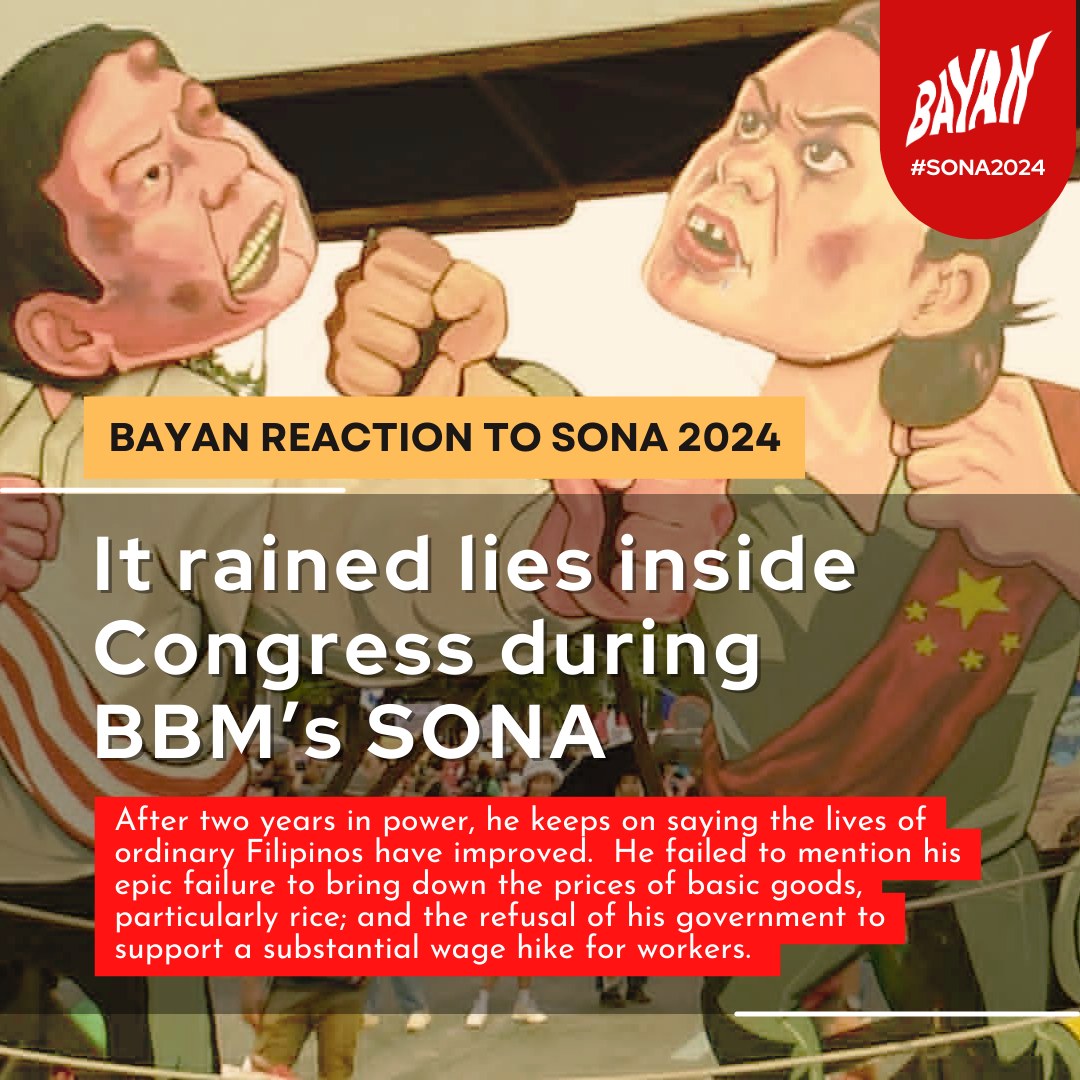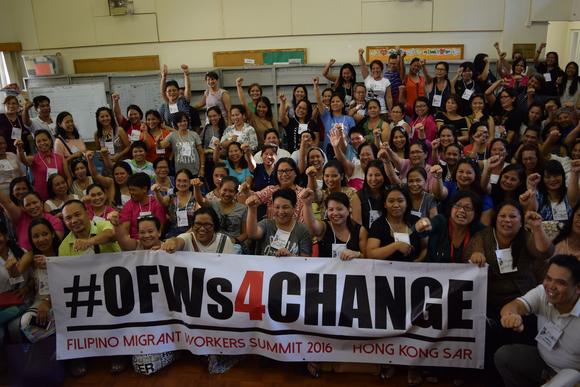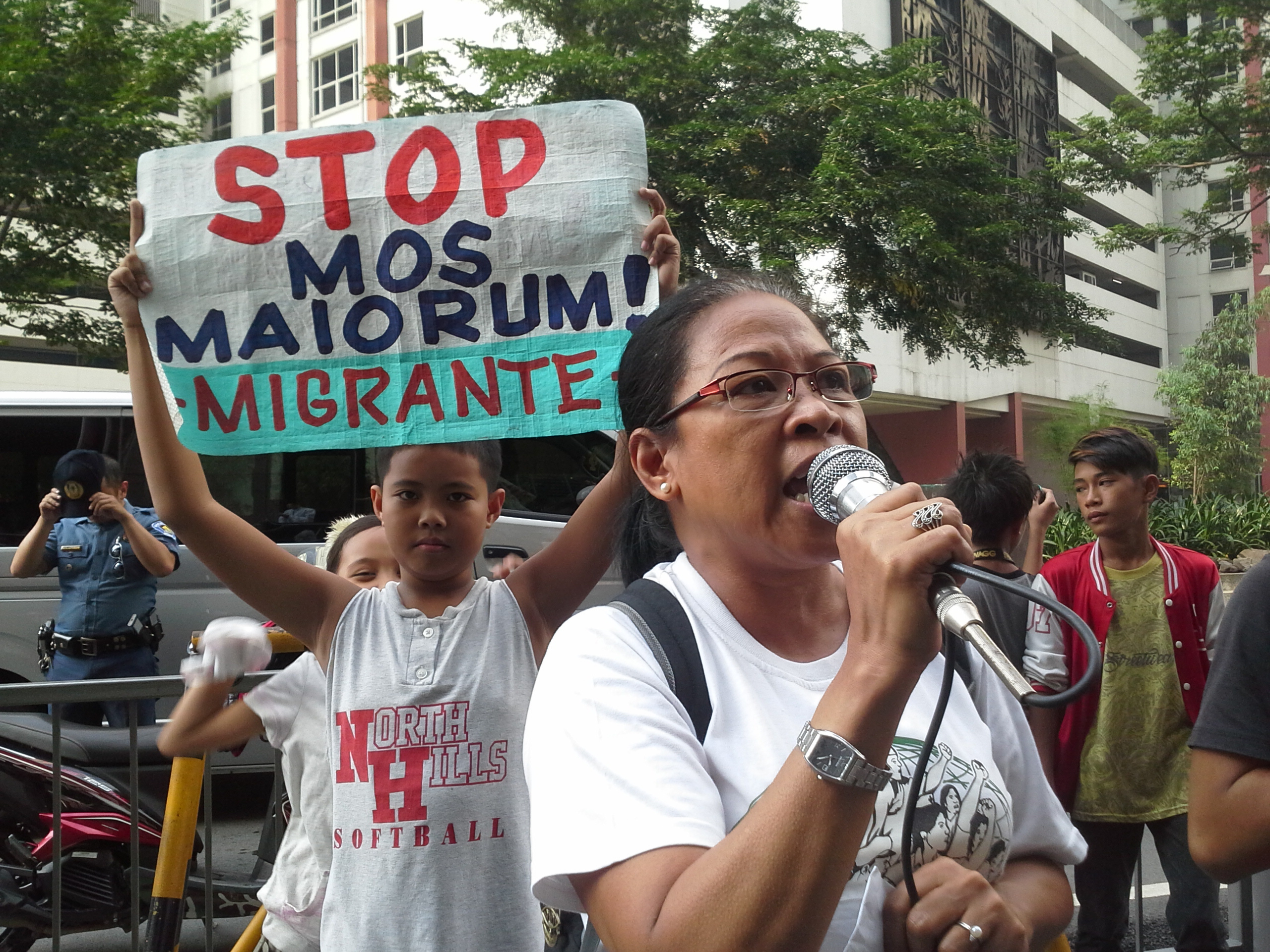(Orignally posted by Belarmino Dabalos Saguing in Center for Migrant Studies and Researches, Rome, Italy 03 Dece4mber 2014)
Italy is host to more than 4 million migrants of diverse nationalities. They comprise about 5 percent of the country’s total population.. Fifty percent of the migrants are Europeans, 20 percent are Africans, twenty percent are from Asiatic Countries, and ten percent from the Americas, predominantly South and Central American.
About sixty percent of the immigrant community are living in Northern Italy, twenty seven percent are in Central Regions, and about thirteen percent in Southern Italy.
The main worry among the immigrants is the problem of housing, employment and their integration to the Italian society. Many migrants has to struggle to pay rents, and for the majority, buying a house is just out of reach. On the average, the income of migrant workers in Italy is half of the income of the average Italian worker. There is no job security for the immigrant population, and many of them do not have regular work. ( Data from CARITAS Report of 2010)
Italy has been one of the countries in Europe that experienced a sustained growth in Filipino labor migration. The works at home previously carried out by Italians, men and women alike, are not compensated by the public service.
It should be well noted that the political conditions and rising economic growth in Italy, the labor segmentation, the demographic collapse, among other factors, has necessitated the services of migrant workers including domestic services has increased the demands for Filipinas.
However, Italy is distinguished from the others since it was more through the personal initiatives of the migrants themselves rather than the planning of the Philippine government that brought most of them to this country, to flee from poverty and lack of employment that would support decent life for workers in the Philippines.
Philippine-Italy studies indicate that most Filipinos travel with tourist visas and found works here afterwards. The advent of stricter immigration policies in 1986 made this mode of entry more difficult, forcing the migrants, Filipinos included, to find other means to enter the country, legally or otherwise, despite the insertion of more formal migration channels.
The Number of Filipinos in Italy
In 2006, the Philippine Commission on Filipinos Overseas (CFO) estimated that there are 128,080 Filipinos residing in Italy: of which 23,108 are permanent residents, 84,972 are OFWs (temporary workers whose stay in foreign countries are limited by the duration of their contracts), and the remaining 20,000 are illegally working and living in Italy
The CFO estimates maybe a bit conservative since they are basing their count from the annual departures from Manila airport. Since the Philippine government normally has no direct control on the contracts signed by the workers in Italy, and their estimate on undocumented migrants is based mainly on the estimates of the Philippine Embassy in Rome. It should of course be noted that other estimates indicate higher numbers of Filipinos residing in Italy with some guess indicating that there are more than 200,000 Filipinos residing in Italy.
The CARITAS di Roma 2013 reported that there are 165, 763 Filipinospresent in Italy of which 46, 773are in surrounding Lazio province in Rome of which majority are concentrated in the city of Rome and it indicated indicated that about sixty-one percent of them are women.
Incongruent may be these figures, these studies and estimates confirm the fact that within Europe, Italy is host of the largest Filipino migrants community in Europe preceded only by Spain, Greece and Austria. Italy is among the top ten destinations of Filipino migrants preceded only by Saudi Arabia, Hong Kong, Japan, Taiwan and the United Arab Emirates. The largest concentration of the Filipino migrants in Italy could be found in Rome and Milan and its surroundings.
The Feminized Migration Flow to Italy
The researches of the Italian Institute for Statistics (ISTATS) concerning the regular temporary workers in Italy points out that women comprise about sixty-three percent of the migrants present in Italy. Sixty to seventy percent of the Filipinos are employed in the service sector, with Filipino women in large majority. In cities like Rome and Milan female Filipinos account up to seventy percent of all Filipinos in these cities. It cannot be considered an exaggeration to say that Filipino outward migration to Italy and elsewhere has always been dominated by women.
The great majority of Filipino female migrants work in the domestic service according to some specific studies, points out that ninety-five percent are employed in domestic field. Nursing and employment in the entertainment sector and employment in hotels are the other fields where Filipinas are represented in minor numbers. It is noteworthy that the economic recession in the Philippines in the mid-90’s led to the presence of male migrant labor in Italy, although women are still in great majority. It is also the Filipinas who made great efforts to reunite their families in Italy more than the other nationalities when the Italian migration policies made it easier for the migrants to petition the entrance of the members of their family into Italy in the mid-90’s. Also, three profiles of the Filipinas are distinguished: married women with children, single mothers and singles women.
Education and Income Levels
Although it is somewhat difficult to assess the exact figures regarding the different levels of education characterizing the Filipinos in Italy, anecdotal evidence indicates that the Filipino migrants are more than fairly educated compared to other migrants present in Italy, The majority of Filipino migrants are high school graduates, and most having at least some university education. Philippine sources have the same conclusion. Many of them are even university graduates and most are experienced skilled workers before leaving for overseas. It could, therefore, be concluded that it was the salary, living conditions or job opportunity factor that drove most of them to migrate.
The Filipino migrants in Italy could now be classified as being part of the middle-class in the Philippines, despite their relatively low income in Italy. It should be important to note that the middle class in the Philippines has diminished drastically in the years of the Marcos regime. Vast numbers of the Filipino middle class has fled the country for political or economic reasons due to severe repressions during that period, and the majority of those who remained were either absorbed by the lower classes, and few, indeed very few, were graduated to the upper class.
Remittances
In 2004, the total remittance of Filipino migrants was 8.5 billion US Dollars. These figures does not even include remittances sent through informal channels which, should it be included, the total could reach a very much higher figure.
Of the total USD 20.5 B sent by the OFWs scattered in the whole world in 2013, more than USD 46 M was from the OFWs in Italy, making them the fourth in the rank of remittance sender to the Philippines.
The actual bulk of remittance sent by the OFWs into the country for that year was estimated between US$14 billion to US$21 billion (1/3 from USA, 1/3 from Middle East and 1/3 from other countries) based on the studies for the Asian Development Bank (Kevin Melynn, ADB Consultant, Worker Remittances as a Development Tool: Opportunity for the Philippines, ADB, 2003)
The present restrictions on money transfers that is being enforced by the Italian authorities, may make it harder to estimate how much really are being sent from this country. Most of the undocumented Filipino migrants can not avail of the services of banks and money transfer firms and are forced to use informal venues to send their money to their families, and this, of course can not be included in the estimates on the total remittances.
François Bourguignon, World Bank Chief Economist, wrote: “We have now a research program on migration issues surrounding remittances, high-skilled migration, temporary movement of persons, social protection and governance of migration, and the link between trade, foreign direct investment, and migration.” – Global Development Finance 2003 Annual Report. (Global Economic Prospects 2006: Economic Implications of Remittances and Migration.)
In the midst of a crisis, they use this tool as a crushing vise in exploiting the country. The Philippines, like all the labor exporting countries, are dependent on the remittances being sent home by the migrants. In fact, about 10% of the nation’s Gross Domestic Product income are the remittances of the OFWs.
The impact of the Global Financial Crisis
“THE PRESENT SITUATION IS THE CULMINATION OF DECADES OF NEOLIBERALISM, CORPORATE GLO-BALIZATION AND FINANCIALIZATION BETWEEN 1995 AND 2007 THAT REDUCED THE SHARE OF INCOME GOING TO WORKERS’ WAGES BUT INCREASED THE SHARE GOING TO THE FEW RICH CAPITALISTS AND CORPORATES IN THREE QUARTERS OF THE WORLD’S NATIONS.”
– Prof William K. Tabb
The words of this American Economist echoes the sentiments of world’s workers including the migrant workers who are shouldering the heavy burden of sufferings caused by globalization, and now, the same workers again has to be sacrificed by the people who created the sufferings by saving themselves and leaving them in a mire of hardships they have to endure.
The problem has hit most the lower income bracket workers which includes the migrants. Thousands has been the victims of retrenchments or cutting shorts of working time and lowering of salaries. The migrants most affected in Italy are those working in factories, constructions, and hotel/restaurant and supermarket services, where hundreds were laid off or whose working times are abbreviated. But worst is the flight of those who do not have regular contracts since they cannot avail on unemployment compensations and has to tighten their belts. There are still no official record of Filipino migrants in Italy directly affected by the global crisis, but sixty to seventy percent of Filipino migrants in Italy are in the service sector most domestic workers.
This phenomenon is universal. Like this crisis, it is global. It affects both rich and poor country, although the third world countries are hit harder because they are dependents of the neocolonist countries, they do not have the means to remedy the situation.
Like the others, Filipino migrants has suffered the same fate. I do have the data on migrants of other nationalities, but the table shows how the loss of jobs, and also the stoppage of jobs long awaited by other workers that is by now held in abeyance by the employers in the countries of destination caused by the global crisis, is real and steps has to be done specially by the countries that are dependent on the remittances being sent home by us migrants. The Philippines is the world’s third largest recipient of remittances after India and Mexico, The remittances of Filipino migrants represent 10.5 percent of the country’s GDP, and about 20 percent of the country’s total earnings. The diminished numbers of remittance senders could also affect the national economy.
In terms of human sufferings, almost all of the migrants, with a few exceptions are from the poorest sectors of the society of the country where they are from. The loss of jobs would mean hunger for many families. And since the majority are not covered by unemployment insurance, it would mean more than just being hungry. It would mean the education, housing and many others.
Italy: the frontline of Fortress Europe
Italy has seen a sustained inward migration in the past 20 years, given its geographical position in the center of the Mediterranean, with more 8,000 km. of coastline, the country is considered as the most accessable to Europe by the migrants of many countries of origin.
The economic gaps between various regions of Italy also governs the way in which migrants has entered the labor market. In the north, more markedly in the industrialized northeastern regions with a low unemployment rates, immigrants are mainly employed in industrial activities and are occupied in more or less regular positions. In the central regions, notably in the city of Rome and its surrounding provincial regions populated by well to dos, the migrants are employed in the service sectors, mostly as domestic helpers, nannies and caregivers especially the female migrants, In the South, the majority of migrant workers are employed in seasonal jobs and in the clandestine underground economy particularly in agriculture and construction sectors.
Aside from legal immigrants with regular documents and resident permits, there is a great number of illegal migrants present in Italy. There are no precise count available for the clandestines. The only estimate availble is from the Caritas, a Catholic Church agency which gives assistance to the poor including the clandestine migrants.
Because of negative propagandas by some political parties particularly the extrem right Lega Nord and Forza Italia, criminality was tied with clandestine migrants, breeding hatred and distrust among the people. As a result, incidents of migrants being mauled by some extremist gangs, leading in some cases, to death of the victims has occurred. Due to discriminations, migrants find it very hard to find work and accomodations. They are also deprived of social rughts and services.
Immigration Laws
The earliest attempt at regularizing and integration of migrants was conceived in latter parts of 1988 and finally was approved by the Italian Parliament in the beginning of 1990 as Law 39/90 otherwise known as the Martelli Law. This law aims to make plans on migratory inflow to the country with the collaboration of the immigrant’s country of origin. This law was later further amended by the Amato-Ferrero Law.
In 1998, the center-left coalition government passed the Law 40/98 also called the Turco-Napolitano Law which was an attempt to regularize the position of non EU immigrants and improve their integration into Italian society. This law imposed an intricate procedures for the deportation of illegal immigrants, who, once accosted by the authority and tried by a magistrate and could be deported in the event that he is judged by the court as illegal immigrant. The immigrant is given 2 weeks to appeal his case. In most cases, this period is utilized by the migrants to go underground.
The Bossi-Fini Law
The xenophobic leader of Lega Nord Umberto, Bossi and the extreme right Forza Italia of Silvio Berlusconi criticized the Law 40/98 as too soft. The Center-Left coalition used, what in their opinion, the shortcomings of the law, and the black propaganda against illegal immigration, as campaign issue and won the May 2001 general election. From the onset of their coming to power, the Center-Right government has made the immigration issue a priority and after a bitter debate in the Parliament, passed the Law 189/2002 that regulates immigration in a more strict term and issued a decree to regularize immigrants already present in the country.
This law 189/02 also known as Bossi-Fini Law named after the politicians who proposed it, took effect on July, 2002, amended the 1998 Imigration Law and introduced new stringent clauses. The most significant aspects of the law are the following:
- Before November 30 of each year, the Prime Minister will lay down the number of non-EU workers to be admitted into Italy for the following year (the so called Flussi Decree).
- There shall be no limitations for the entry in Italy for highly skilled workers (university lecturers and professors, professional nurses, etc.).
- Other workers of non-EU origin will be allowed to enter Italy only after obtaining a “residence contratct”, signed both by the employer and the worker (contratto di soggiorno).1
- An immigration office will be set up in every province of Italy to oversee the rectruitment all migrant workers.2
- Residence permits for reason of employment with a maximum validity period of 2 years shall be issued to migrant workers.
- Clandestines and irregular workers shall be accompanied by the authorities to the border and deported. Deportations are immediate and cannot be suspended even through an appeal through the courts.
- After 6 years of regular residence in Italy, non-EU citizens with stable jobs and the necessaty economic requisites to support themselve and their family may apply for a permanent residence permit.
- Minors of non-EU origin in Italy shall be issued a residence permit when they reach adult age (18 years), provided that they have already lived in Italy for at least 3 years, and have attended a social and civil integration programme provided by a public or a private organization. This organization must guarantee that they have adequate accommodations, study school or go to work. The number of resident permits issued on this condition shall be deducted from the pre-defined number of total annual permits.
Regularization
A decree on regularization was issued on 6 September, 2002 provides the regularization of of two types of irregular immigrant worker: The undocumented or clandestine migrants who had not been regularized since ttheir entry into the trretory and the irregular immigrants with expired residence permits. The categories include Domestic workers and home helpers, ie:caregivers and nannies; and other dependent workers engaged in other suburdinate employment.
The requirements fot the regularizations are as follows:
- The worker must have been employed by a company or individual employer for at least 3 months.
- The employer must agree to engage the worker on an open-ended or on a fixed term contract the worker must receive a minimum monthly salary of € 700
- within 10 days from the submission of the application for the regularization, both the worker and employer shall be convoked by the prefecture or the police to formalize the working contract.
And to other EU Member States for instance, there is anecdotal evidence indicating that a number of Filipino domestic helpers brought along by their Arab employers for a vacation in Europe succumb to the temptation of abandoning their employment in favour of irregular stay in Italy or Europe with the help of other Filipinos.
The CFO does not have any available information on human trafficking or smuggling activity involving Italy. Meanwhile, there are some reported cases of Filipinos being recruited for fictitious work in EU countries including Italy, with the aid of illegal recruiters – Filipino and Chinese – using fake passports and visas.
A 2006 advisory from the POEA reported that some Filipinos in Hong Kong were lured into paying HKD 25,000 to HKD 40,000 (or USD 3,214.83 to USD 5,143.73) for their plane tickets and for processing tourist visas for Italy (POEA, 2006a).
Migrant workers who are in Italy without the proper work documentation are ineligible for basic social services and often find themselves in vulnerable and exploitative work conditions. They cannot access formal financial, banking or remittance services because of the inability to present formal work documents, or for fear of disclosing their undocumented status. This sector has no choice but to send money home through informal channels and, as the survey showed, keep their earnings at their residences or carry money personally wherever they go. It is expected that these irregular workers will persevere in such status in the hope of obtaining amnesty in the future.
A significant number of undocumented Filipinos in Italy have availed of the amnesty and regularization program offered by the Italian Government. The last amnesty was in 2002,when 646,829 foreigners were granted permits – including 9,820 Filipinos. Among regularized migrants who are in domestic work, Filipinos (89% of regularized undocumented domestic workers) are the biggest ethnic group (Carfagna et al., 2008). From June to September 2009, the Italian government accepted amnesty applications from irregular foreign workers (Buenafe, 2009).
Integration and occupational mobility of Filipinos. There are programs and procedures available to foreigners who wish to upgrade their credentials to qualify themselves for higher occupations. Among these are advanced professional training programs administered by the regions.7 Legal recognition of academic qualifications through an application with the appropriate university or educational institutions, which must issue decisions within prescribed periods, or recognition of professional titles such as nurses, doctors, teachers, lawyers, accountants, biologists, consultants, and various other expertise may be obtained through applications filed with the different ministries. The basic requirements are a high level of knowledge of the Italian language, and a valid permit to stay, aside from educational credentials and other requirements. Scholarships and grants are also available to those wishing to pursue higher studies.8 Some of the key informants suggested that Filipinos are not benefiting from such programmes, as a good number of Filipinos are juggling multiple jobs to augment their incomes to support the family’s immediate needs or pay for various financial obligations, leaving no time for upgrading their skills.
Filipino migrants often do not have time for self-improvement because of their multiple work engagements. In the words of Cristina Liamzon, a Filipino advocate for socio-economic empowerment, Filipino migrant workers “lack the confidence or mindset for self-improvement, in availing of language and training programmes, or even educational grants, particularly those offered by city or provincial authorities.” 9 This stresses the need for more initiatives in capability building and raising awareness of opportunities for the Filipino community. As many of these workers are focused on increasing their incomes through hired work, and few are self-employed, the Filipinos as a group miss out on the numerous entrepreneurship programmes promoted by the Italian government.
Whether due to the pressure to provide for the family’s needs or to cultural inhibition, a good number of Filipino workers prefer earning a stable income by taking more than one domestic or caregiving job. Doing so enables them to send more remittances and/or increase their savings. This is preferable to upgrading their skills or handling a business that does not offer prospects of financial gains in the short term. As the survey for this research reveals, many depend on a stable high income to pay for investments, house amortizations, insurance premiums and loans in the Philippines.
Those who advocate that in the long term, it would be beneficial for migrant workers to take advantage of such training courses (which reportedly are in abundance) may perhaps highlight stories of migrants who successfully made the leap from domestic to professional or self-employed status.It is also possible that there could be cultural barriers involved, since such training courses are reportedly provided by Italian agencies in Italian language. It may therefore be worth studying by the Philippine NGOs in Italy that they initiate the conduct of such training courses in the embassy or Filipino church grounds. A vehicle to do this might be the Filipino Workers Resource Center (FWRC), whose successful FWRC skills training in Kuala Lumpur can be replicated in Rome and/or Milan, where there are none at present.
Filipino youths in Italy. The family reunification policies of Italy have provided for Italy-based Filipinos a remedial solution of sorts to address issues relating to the prolonged absence of their loved ones, as well as expanding their household’s income base. The outcome of the family reunification, however, appeared to be a little rather more complex. For one, there are concerns that Filipino youths in Italy face immense challenges, including cultural adjustment and acculturation. Some are seen engaged in socially destructive behaviour such as juvenile delinquency and drug abuse, particularly among Filipino youths whose move to Italy was decided by their parents. Given this opportunity to join their parents, there are also documented cases of children not finishing their schooling in the Philippines to join their parents in Italy and become domestic workers (Añonuevo & and Añonuevo, 2002). The Italy–Philippines Migration and Remittance Corridor
The Italy–Philippines Migration and Remittance Corridor
In another survey of 99 Filipino youths and 101 parents and NGO workers in Rome (Liamzon, 2007), it was found that:
- Filipino youths in school face serious social and academic problems, given their lack of Italian language skills that hinders them from making friends; and
- Filipino parents admit to difficulty in dealing with the struggles their children face in integrating into Italian society, especially in circumstances where many parents have the desire to work extra hours to augment the family income. Children (especially those aged below 18 years old) complain of lack of family time, and of the decision of their parents to have them come to Italy.
While documentation on the Filipino minor population is not available, the issues that face the youth are worthy of consideration, as many of them appear to have been forced to move to Italy in order to contribute to the family income. Their inclusion in programs on the productive use of remittances might be considered as early as possible, although psychosocial counselling appears also to be a paramount need. In the long term, the real cause for concern regarding migrant Filipino minors is the emergence of a generation of OFs in Italy that pose new challenges to:
- both the sending and receiving governments in terms of the demand for the smooth integration of the young migrants transplanted in a new country;
- OFs who have to cope with their socially and culturally challenged youth; • the Philippine government that must prepare for the future reintegration of Italy-based
- Filipinos that may want to return to the Philippines upon retirement or old age.
The global economic crisis and Filipinos in Italy. Many expected the global economic crisis that began in 2008 to affect migrants in various ways. The impacts, as mentioned by IOM (2009), include:
- restrictions on new admissions of migrant workers and non-renewal of work permits;
- job losses, wage reductions, ineligibility of newly arrived migrants for social benefits;
- racism and xenophobia;
- return migration of displaced migrant workers;
- diminished remittance volumes for countries;
- Increased irregular migration; and
- specific gender issues, e.g. which gender was more affected by job attrition.
The admission of new migrant workers was heavily restricted in Italy. For the first time, in 2009, no quotas were provided for new workers except for 80,000 slots for non-EU seasonal workers. A report by the OECD (2009) states that Italy may see its employers abandoning applications for immigrant workers. Last year, about 10,000 employers withdrew requests for immigrant workers. However, it seems that demand for domestic workers remains significant in Italy and elsewhere despite the downturn. Most (at least two thirds) of the 2008 quota for foreign workers – and the entire quota for entries in 2009 – are reserved for domestic and personal care workers (OECD, 2009). Although the trends do not portend a doom scenario for Filipino workers in Italy (including domestic workers), the Filipinos’ economic survival and better management of resources remain urgent needs.










